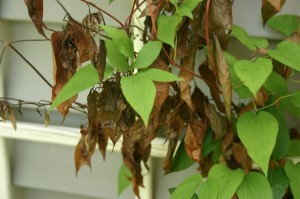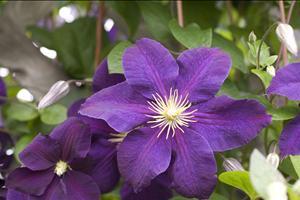Clematis is one of the most popular perennial vines in the landscape. The plant has large or small star-shaped or bell-shaped flowers, depending on the cultivar. The cultivar also determines when the clematis blooms — off and on all summer or only at specific times, such as spring or fall.
The favorites are the large flowering types, including ‘Superba,’ ‘Nelly Moser’ and ‘Rogue Cardinal.’ However, many of these lovely vines are susceptible to clematis wilt (Ascochyta clematidina), a soil-borne fungus disease that sometimes creeps up from the base or sometimes strikes right at the center of the plant. The suddenly wilts, turns brown or black and the leaves dry up.
Although a common, opportunistic disease on Clematis in Indiana gardens and elsewhere, fortunately, the wilt does not usually kill the plant. The remedy is to cut out the damaged area to the ground and remove from the soil any leaves that fall from an infected plant. More vines will grow from the roots and the plant will likely recover in a year or two. A chemical treatment is not recommended.
Over the last few years, several clematis cultivars have been introduced by the English breeder Raymond Evison, which are considered resistant to the wilt disease.
There are three types of clematis and knowing which one you have will help with the always-puzzling pruning questions.
Group 1 — includes many of the alpines, which have smaller flowers. These bloom on year-old growth, so no pruning is required unless it is to control size.
Group 2 — blooms on current season growth and year-old growth. Prune in early spring as needed for shaping or to remove winter damaged or dead growth. This group includes ‘Nelly Moser,’ ‘Niobe’ and ‘Multi-Blue.’
Group 3 — blooms on new growth, so it can be cut back to 10- to 12-inches from the ground in early spring. This group includes C. jackmanii ‘Superba’ and ‘Comtesse de Bouchaud.’
Here are some more resources:
[download id=”29″ format=”2″]


